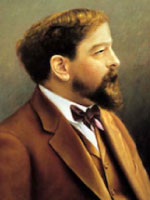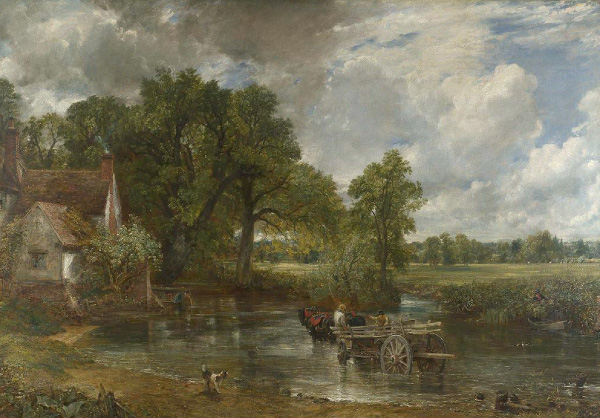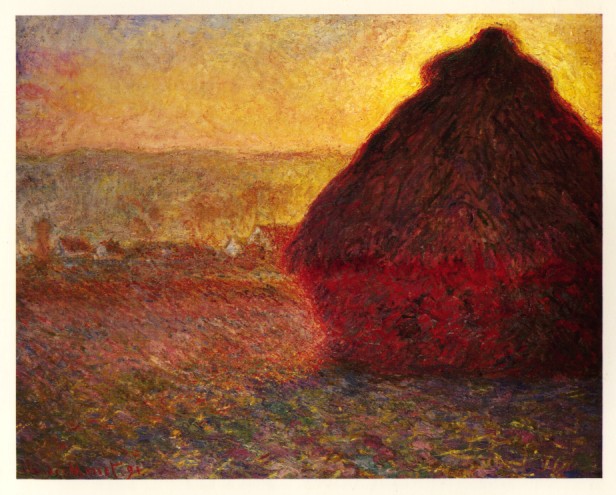|
|
Claude Debussy
|
|
Claude Debussy often found inspiration in other art forms. He took a strong interest in literature and in visual art and used these mediums to help shape his unique musical style. He rejected realism in art and when composing music, searched for new compositional approaches that would wake the senses of the listeners, helping them “feel” a musical image rather than “see” its sharply defined details. Perhaps the sound of Debussy’s music is best explained by comparing a painting by one of France’s great impressionist painters, Claude Monet, with a painting by John Constable, one of England’s great romantic painters. Below are the two paintings.Painters in the Romantic Period not only tried to capture the scene they were painting with great precision, but in their use of light and color, also highlighted aspects of the scene that would evoke awe and emotion among those viewing the painting.
Figure 1 – Constable: The Hay Wain Look closely at the painting by John Constable. Is there a particular area of the painting that draws your attention? Focus your eyes on that area. What’s happening in that spot that pulls you toward it? Can you describe how you are feeling as you look at it? There is a dark area in the painting that seems to draw attention. The dark, menacing cloud and the dark area in the trees underneath the cloud suggest an approaching storm. Look closer and you’ll notice that the two people at the wagon seem to be looking in that direction; one is pointing. The dog on the shore of the river is looking toward the people at the wagon. What about the duck in the lower right-hand corner; do you think it’s landing on the water or scattering in search of safer ground? If you were in that painting, how comfortable would you be staying in the river with the wagon and horses? Might you feel inclined to run for cover to avoid the approaching storm? As you can see, Constable has imbued his painting emotions. In this case, tension and anxiety. Impressionist painters worked differently. They sought to capture the moment, to paint what they could see at the very moment they were seeing it. They often painted outdoors and worked quickly to capture the light before it changed. It was the light and color of the moment that concerned them, far more than the details of the objects they were painting. They used rapid brush strokes and often used unmixed color to save time. They used unusual visual angles and common everyday subjects.
Figure 2 – Monet: The Haystack Look at the painting of the Haystack by Monet. You might be thinking: “I could paint a better haystack than that!” Perhaps, but don’t forget, Monet was not attempting to reproduce all the minute details of the haystack in order to create a precise, almost photographic reproduction, but rather was painting his “impression” of the haystack in the early morning as the sun rose on the field. The image he created is almost blurred, as perhaps it was that morning as the moisture in the ground began to steam under the heat of the rising sun. MUSIC MEMORY SELECTION: Now let’s listen to the music of a composer belonging to the Impressionist Period. Claude Debussy’s Clair de lune (in English, Moonlight) was composed in 1890 as part of a larger group of pieces for piano entitled Suite bergamasque. The French word bergamasque refers to a type of rustic dance, and les bergamasques are the dancers who perform the dance. Clair de lune is the 3rd movement of the Suite. Debussy based his music on a poem, also entitled Clair de lune, by the French poet, Paul Verlaine. Here is the text of the poem that inspired Debussy: Clair De Lune
Your soul is as a moonlit landscape fair,
The while they celebrate in minor strain
The melancholy moonlight, sweet and lone, As you listen to the music, think how you might describe Debussy’s impression of the moonlight and what it reveals.
Canadian pianist Angela Hewitt plays Debussy’s Clair de lune:
The next video will give you a visual representation of the music the pianist is playing. The blue notes represent the music the pianist’s left hand is playing; the green notes, the right hand. As you listen and watch, remember that you are listening to a machine play Debussy’s music, a machine that lacks the artistry of Angela Hewitt’s live recording. Nevertheless, this video will give you an idea of just how busy any pianist’s 10 fingers will be when playing Debussy’s Clair de lune:
KEYWORDS:
lute / bergamasque / imbue / Let’s highlight certain phrases of Verlaine’s poem:
Even though Verlaine writes of music and dancing in his poem, his images have an air of sadness about them.
|
|





